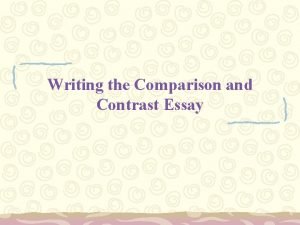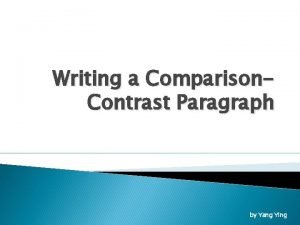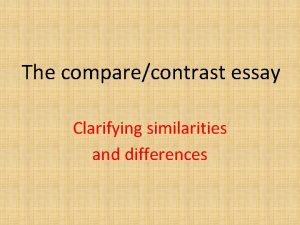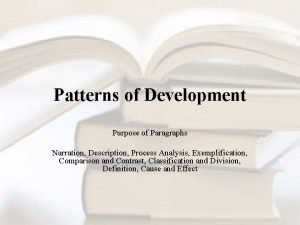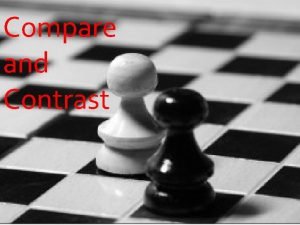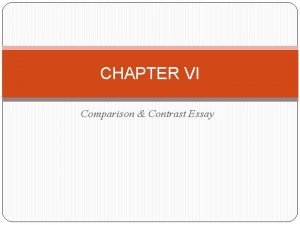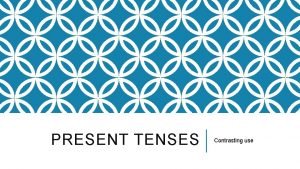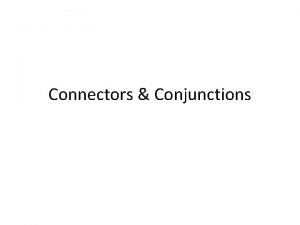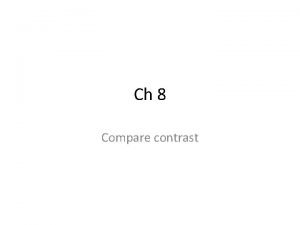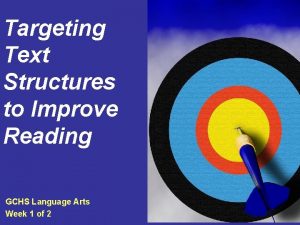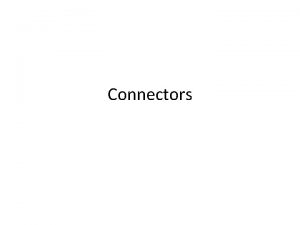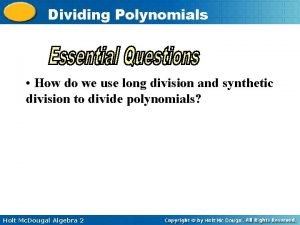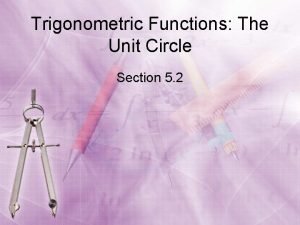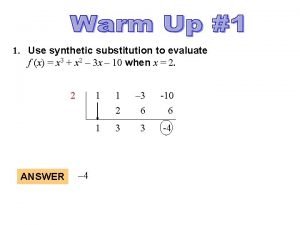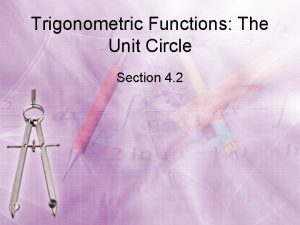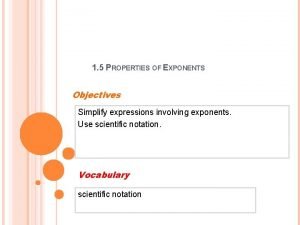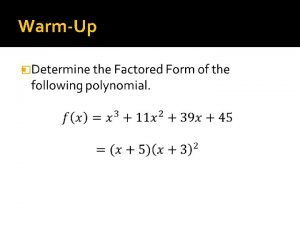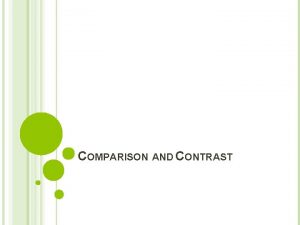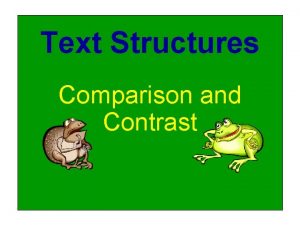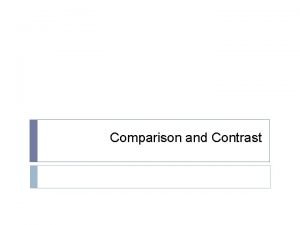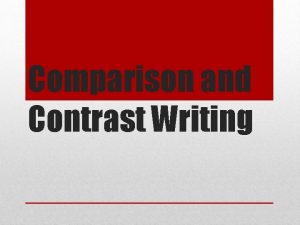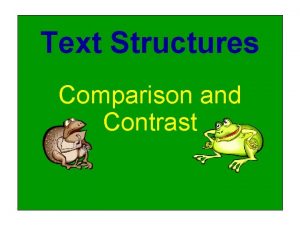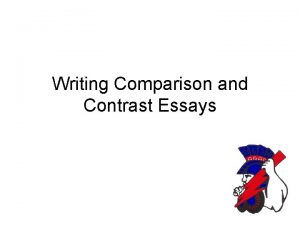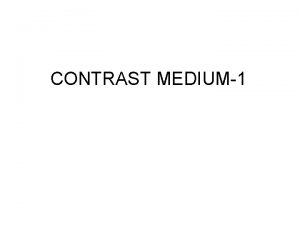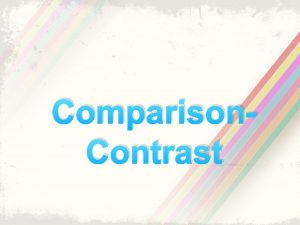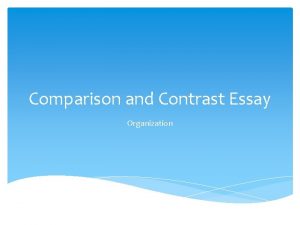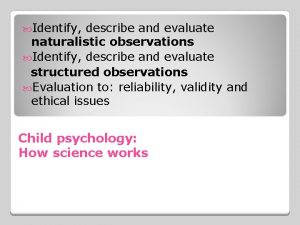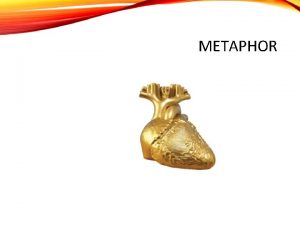Using Comparison Contrast identify discuss use evaluate concepts




















- Slides: 20

Using Comparison & Contrast • identify, discuss, use, evaluate concepts and techniques of comparison, including – – block and alternating methods basis of comparison / points of comparison logical & rhetorical comparison analogy, parable, and parody • identify and evaluate elements of comparison in sample essays / visual texts • organize an essay comparing two texts 1

What is Comparison? • Comparison shows similarities between and among people, things, ideas. – a. OF. compere-r lit. ‘to pair together, couple, match, bring together’, f. compar like, equal, f. com- + par equal. ] • Contrast shows the differences. – a. F. contraste (masc. ), ad. It. contrasto (= Pr. contrast, Sp. contraste) contention, opposition: • The term “comparison” includes both kinds of analysis. • Simple comparisons can be between two things, ideas, etc. • Complex comparisons can examine similarities and differences among many subjects. 2

How is comparison used? SSW, Ch. 12 • helps us choose between alternatives • acquaints us with unfamiliar things • examples: comparing – – – several phone systems candidates for a job patient’s condition before and after treatment one essay to another a number of GPS products 3

Developing a Comparison • Items compared must share some common ground – many possible points of comparison: e. g. , fences & windows; innocence and experience – no basis for comparison: chicken and charcoal – (you decide): golfer and a car • A valid comparison – presents many possibilities – uses ample, well-chosen details to show items compared are alike / different. 4

Basis of Comparison • Comparison helps you and your reader / listener better understand – the things you’re comparing – the more general concept that’s the basis for the comparison – Element of genius , or trained insight, required • basis of comparison: the common element in terms of which you will compare something – there must be a common element connect the items being compared to make the comparison useful. 5

Organizing a Comparison • Two main methods or patterns of comparison: – Block: presents one subject fully, then the other / others • SUBJECT A: point 1, point 2, point 3, point 4 • SUBJECT B: point 1, point 2, point 3, point 4 – Alternating (point by point): different aspects of subjects are compared sequentially • SUBJECT A, Point 1; SUBJECT B, Point 1 • SUBJECT A, Point 2; SUBJECT B, Point 2 6

Patterns / Methods of Comparison Block Pattern Alternating Pattern • say everything you have to say about one subject before discussing the other • compare subjects one aspect at a time, point by point • useful when developing only a few main points about a few subjects (short texts), without extensive quotations or evidence • good for essays over 500 words and for detailed comparisons 7

Use a table to organise basic information • Block Pattern: organize paragraphs / sections by Item, “vertically” • Alternating Pattern: organize paragraphs / sections “horizontally, ” based on points of comparison Points of comparison Leadership Qualities Persistence in task Analytical abilities Practical Creativity Intangibles Item #1: Male Engineers Item #2: Female Engineers

Comparison: Types / Simple • Simile: ‘as’ or ‘like’: – “My love is like a red, red rose” • Metaphor: (lit. carrying across) ‘this for that’. – ‘You are toast!’ – Time flies (movement); the weekend is just around the corner (space); exam time is upon us (action). • Allegory: “If the resemblance. . be long dwelt upon, and carried into all its minute circumstances we make an allegory instead of a metaphor. . . This is called straining a Metaphor. ”

Comparison: Types / Extended • Consistent with the polar approach of Western culture, rhetoricians sometimes distinguish between two types of comparison: – logical / objective / denotative: often used for explaining: The Internet is an information highway…. – rhetorical / subjective / connotative: often used for persuading: This candidate’s like an old horse who’s run too many races…. • Other types of extended comparison, beside allegory, are parody, analogy, and parable. 10

Writing Comparisons: point of excellence • Study and highlight your opponent’s strongest point: do not avoid it. – reveals weaknesses in your own position – allows you to respond to the strength – shows you to be fair-minded • Study and highlight your own weakest point. – allows you fix, or even merely acknowledge, it – presents you as fair-minded

Analogy and Parable • Both are often used to explain a new, complex idea or concept in terms of a situation or idea familiar to the audience. – Electrical current is like a river… • explanation can be extended for many sentences using this analogy • Parable (from Gr. parabole, a comparing, or throwing alongside): a short, fictitious narrative from which a moral or spiritual truth can be drawn 12

Parody • from the Grk. , : “a song alongside of” • a writing or “text” in which style and language of one author or text is imitated or mimicked, usually for comic effect or ridicule • BUT parody can also have a serious, critical purpose: can use humour to create insight – parodies of Münch’s The Scream – Jon Stewart & The Daily Show (most TV news shows) – The Sopranos / Analyze This (The Godfather / Goodfellas) – Goodfellas (most “westerns” / “cowboy” movies) 13

"I was walking along the road with two friends. The sun was setting. I felt a breath of melancholy - Suddenly the sky turned blood-red. I stopped, and leaned against the railing, deathly tired - looking out across the flaming clouds that hung like blood and a sword over the blue-black fjord and town. My friends walked on - I stood there, trembling with fear. And I sensed a great, infinite scream pass through nature. ” The Scream, 1893 Edvard Munch’s journal , 22 January 1892 14

Visual Parody http: //www. thecatgallery. com/the_scream_Mu nch_cat_print. html http: //www. impawards. com/1990/ho me_alone_ver 2. html 15

Analogy • from Gr. analogos, a due ratio • extended metaphor or simile • comparison of two quite different things or activities for the purpose of explanation; often used in science writing. – A child is like a tender plant needing care from a skilled gardener. – A mind is like a parachute… • Limit your analogies; don’t draw them out to the point of absurdity. 16

Analogy: Textbook says/Ogden says • Textbook: “an analogy must truly illuminate. Overly obvious examples, such as the one comparing a battle to an argument, offer few or no revealing insights. ” • Ogden: “Wrong. ” • [Text is very useful on the same page (261 -2) on advertising & comparisons. ]

Analogy: Example • Charles Darwin: The Origin of Species • Wanted to persuade audience of the concept of mechanistic evolution—change and development without Divine attention – Darwin’s Concept: “Natural Selection” • Given 1. ] Variation in procreation—organic reproduction—exists • Given 2. ] Stuff [‘nature’] exists • Darwin’s Argument: 1 + 2 = ‘natural selection’ = ‘fittest organisms live and unfit die’=biological diversity. – Darwin’s Analogy: “Artificial Selection” • In animal husbandry, breeders select the strongest & best speciens and breed them to create diversity.

Parable Examples (1) “What shall we say the Kingdom of God is like? ” asked Jesus. “What parable shall we use to explain it? It is like this. A man takes a mustard seed, the smallest seed in the world, and plants it in the ground. After a while it grows up and becomes the biggest of all the plants. It puts out such large branches that the birds come and make their nests in its shade. ” (NT, Mark, 4, 30 -34) 19

(2) A man traveling across a field encountered a tiger. He fled, the tiger after him. Coming to a precipice, he caught hold of the root of a wild vine and swung himself down over the edge. The tiger sniffed at him from above. Trembling, the man looked down to where, far below, another tiger was waiting to eat him. Only the vine sustained him. Two mice, one white and one black, little by little started to gnaw away at the vine. The man saw a luscious strawberry near him. Grasping the vine with one hand, he plucked the strawberry with the other. How sweet it tasted! (P. Reps, Zen Flesh, Zen Bones) 20
 Amateurs discuss tactics professionals discuss logistics
Amateurs discuss tactics professionals discuss logistics Double contrast vs single contrast
Double contrast vs single contrast Comparison and contrast outline
Comparison and contrast outline Comparison contrast paragraph
Comparison contrast paragraph Compare definition
Compare definition Patterns of development definition example
Patterns of development definition example Definition patterns of development
Definition patterns of development Meaning of compare and contrast
Meaning of compare and contrast Concession signal words
Concession signal words Present progressive tense examples
Present progressive tense examples Addition connectors examples
Addition connectors examples Comparison and contrast similarities ball games fun
Comparison and contrast similarities ball games fun Compare and contrast examples
Compare and contrast examples Connectors of addition and contrast
Connectors of addition and contrast How to do substitution
How to do substitution Evaluate trig function using period as aid
Evaluate trig function using period as aid Synthetic substitution
Synthetic substitution Evaluate trig function using period as aid
Evaluate trig function using period as aid Simplify the expression
Simplify the expression Limit comparision test
Limit comparision test Synthetic substitution worksheet
Synthetic substitution worksheet


